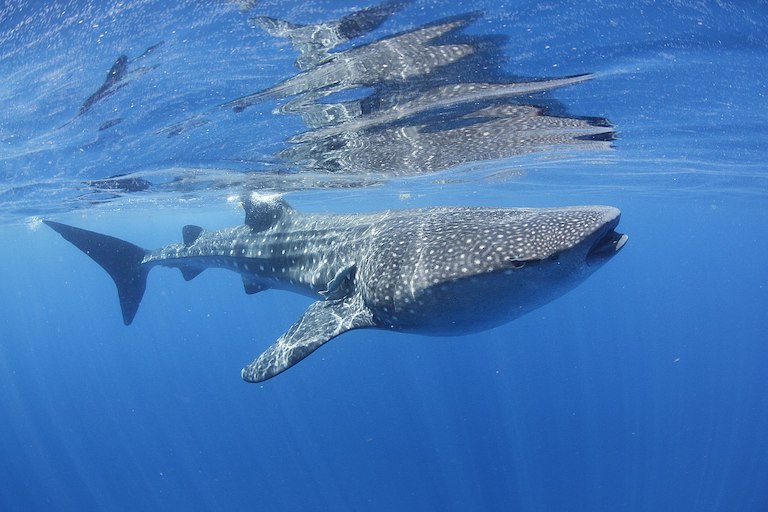- “Ecuador is proud to announce the creation of the Hermandad Marine Reserve in the coming days,” the country’s president announces in a statement shared with Mongabay.
- Safeguarding the critical migration routes of vital species like whale sharks and sea turtles will result in healthier and more abundant populations, he says.
- Covering an additional 60,000 square kilometers near the Galapagos, in addition to the existing 138,000 square kilometers, the new reserve will ensure a safe pathway for creatures traveling to and from Costa Rica’s Cocos Island.
- This post is a commentary. The views expressed are those of the author, not necessarily of Mongabay.
“Ecuador is proud to announce the creation of the Hermandad Marine Reserve in the coming days,” the country’s president declares in an opinion piece shared with Mongabay.
His country had initially announced the expansion of the marine reserve encircling the Galápagos Islands in November at the COP26 climate summit in Glasgow, Scotland.
The following day, the presidents of Panama, Colombia and Costa Rica also joined him to announce that their countries intended to create a large marine corridor between the four nations by extending and joining their current marine protected areas.
Here’s President Lasso’s commentary about this news shared with Mongabay:
Stretching up to 60 feet long, whale sharks are the world’s largest fish. These endangered, gentle giants slowly glide over vast distances throughout the tropics, feeding on some of the ocean’s tiniest creatures like plankton, krill, and shrimp.
Two years ago, scientists tagged a 10-foot juvenile female near the Galapagos and named her Esperanza – the Spanish word for “hope.” Over the following eight months, the researchers continuously tracked her travels until they lost her signal, just as her course intersected with a foreign fleet fishing on the border of Ecuador’s protected waters.
There’s no way to be certain about what happened to Esperanza, but her story still serves as a stark reminder that safeguarding marine wildlife solely where it gathers is not enough. Highly migratory species, such as sea turtles, hammerhead sharks, humpback whales, and whale sharks also need protection along the underwater superhighways that they travel along routinely.

Safeguarding the critical migration routes for these vital species will result in healthier and more abundant populations, benefiting not only wildlife but the livelihood of people who depend on tourism and fishing. Recognizing that future success for both humanity and nature requires a sustainable balance between the two, Ecuador is proud to announce the creation of the Hermandad Marine Reserve in the coming days.
Covering an additional 60,000 square kilometers (23,000 square miles) in the Pacific Ocean near the Galapagos, in addition to the existing 138,000 square kilometers (53,2821 square miles), the new reserve will ensure a safe pathway for the many amazing creatures traveling to and from Costa Rica’s Cocos Island, where marine protection was also recently extended. Together, Costa Rica and Ecuador now work to connect two of the world’s most biologically significant and productive marine habitats.
As we speak of historic cooperation, I must mention that the new reserve only came together because of the unified support of both the people of the Galapagos and the fishing industry, and it builds on more than two decades of successful conservation. In 1998, Ecuador created the Galapagos Marine Reserve, protecting more than 50,000 square miles of ocean that hosts some of the Earth’s highest levels of endemism—species found nowhere else. The existing reserve has greatly benefited people, fishers, and nature. In fact, in the following decade after creating the reserve, booming fish populations spilled over into adjacent areas, and commercial tuna productivity nearly doubled, preserving this spectacular array of marine life has also underpinned the growth of three economic sectors – research, fishing, and tourism.
Despite the Galapagos Marine Reserve’s success, climate change, illegal, unreported, and unregulated (IUU) fishing, pollution, and other practices continue to pose critical and growing threats to livelihoods and the conservation of our marine ecosystem. These complex and compounding global challenges surpass the borders of any one country; this is why I, alongside the presidents of Costa Rica, Colombia, and Panama, signed a declaration during the COP26 recognizing our interconnected marine ecosystem and agreeing to tackle together the problems facing our ocean.
See related: Ten nations announce network of marine protected areas in western Indian Ocean

The inextricable connections between the sea, climate, and biodiversity are undeniable. The ocean is one of Earth’s most significant climate regulators – absorbing nearly a third of emitted carbon dioxide and over 90% of excess heat. In short, the planet’s health depends on a healthy ocean, and ensuring a healthy ocean requires cooperation and coordination well beyond individual borders.
By working together to live in balance with nature, we are closer to doing our part in protecting the ocean, and in turn, the climate and planet. Through the creation of this marine reserve, I call on other nations to join this collective effort and successfully preserve the ocean’s irreplaceable biological treasures. In doing so, we honor our motive of Hermandad – symbolizing the unity between the Earth and people, as well as the respect, equality, and fraternity needed among the nations to work towards a common goal: guaranteeing the preservation and conservation of our planet for the current and future generations.
Guillermo Lasso serves as the President of the Republic of Ecuador.
Related listening from Mongabay’s podcast: What can seashells tell us about the health of the oceans? Listen here:













